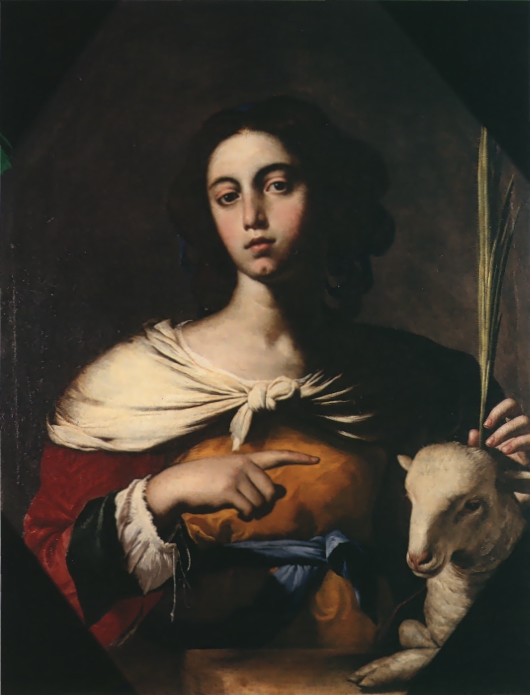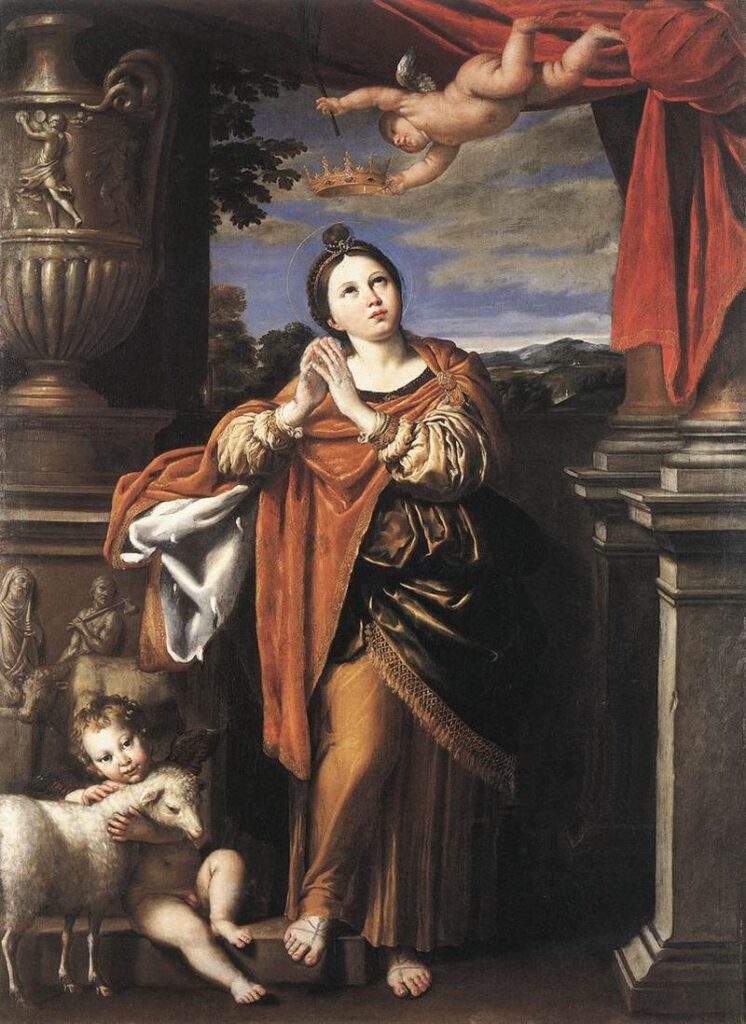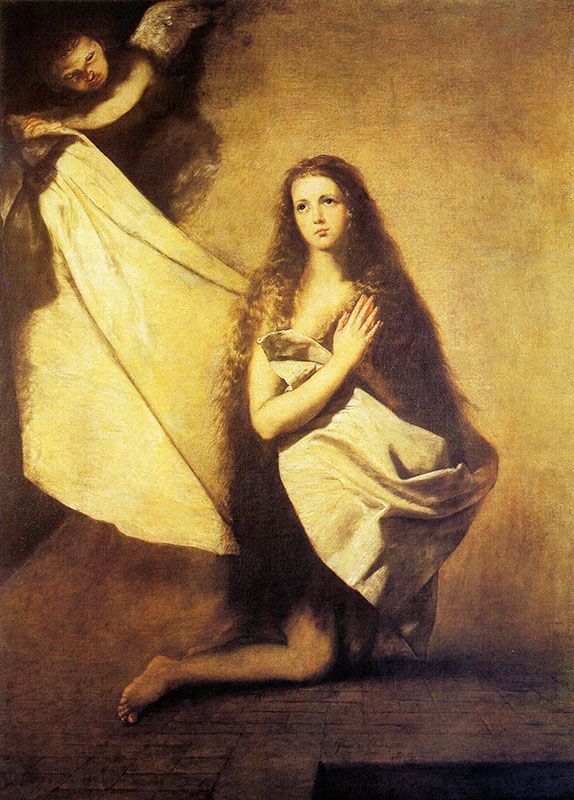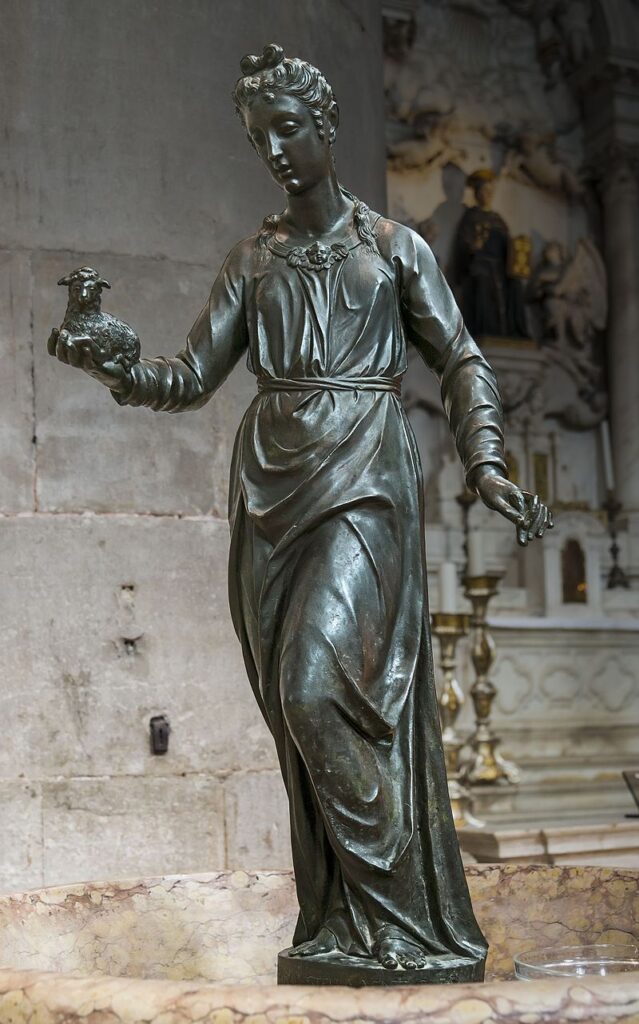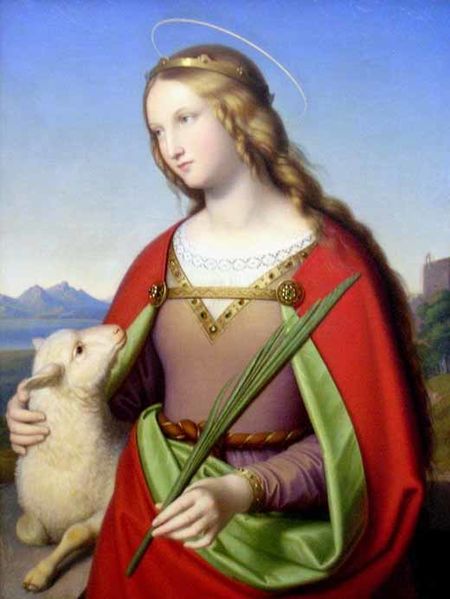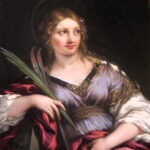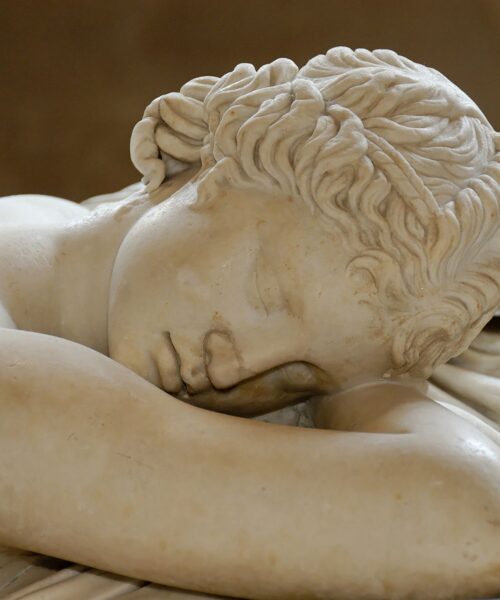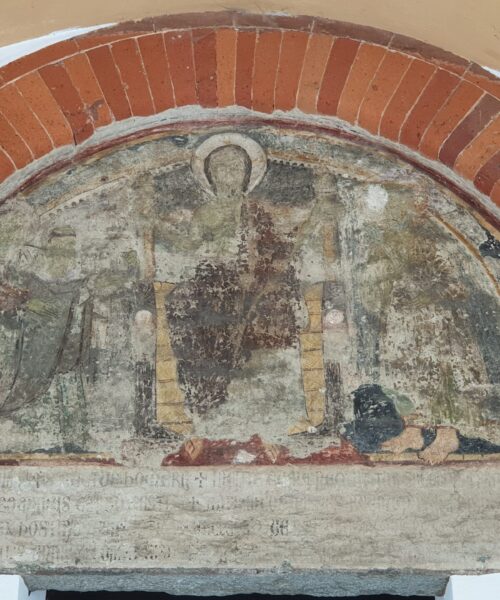In the silent embrace of art galleries and churches, the painted faces speak to us through centuries of history, faith, and unchanging beauty. Among these, Saint Agnes emerges, a figure of devotion and courage, whose life intertwines with the golden threads of legend and martyrdom.
Saint Agnes: The Life of a Christian Martyr
Born into a noble Roman family, Agnes was raised in Christian virtues during a time of persecution. Her beauty and faith attracted many suitors, but she had consecrated her purity to God. Legend has it that, after refusing to marry the son of a high-ranking Roman official, Agnes was denounced as a Christian and taken to a brothel. Miraculously, no man could touch her, her chastity was preserved by a divine light that enveloped her, and her hair grew instantly to cover her nudity. Eventually, she was condemned to be burned at the stake, but the flames divided around her, leaving her untouched. Finally, she was beheaded by an executioner.
The Attributes of Saint Agnes in Artistic Representations
In the eternal dialogue between faith and form, sacred art weaves the narrative of sanctity with strokes that touch the soul. Saint Agnes, martyr and virgin, becomes an icon of this visual communication, carrying the message of her life through the centuries.
Francesco Guarino (1611-1651/54) in his 1650 painting of “Saint Agnes,” presents the saint in a light of divine calm. This solemn representation of Saint Agnes is a triumph of symbolism and delicate execution. At the center, the saint emerges from darkness, almost suggesting the isolation of her martyrdom and her extraordinary purity. Her eyes, slightly elevated, reflect mystical contemplation, a silent dialogue with the ineffable.
The light models Saint Agnes’ face softly, emphasizing her youthful features and dark hair, which fall in gentle waves, symbolizing both her femininity and divine protection. The palm in her left hand is a clear reference to her martyrdom, while her right hand points to a lamb, a metaphor for her innocence and her name, which in Latin means “lamb.”
The lamb, appearing meek and serene, seems to rest confidently by her side, underlining the indissoluble bond between the saint and the Christological symbolism of the Lamb of God. Saint Agnes’ attire is simple yet noble, with a knot at the chest that seems to recall her devotion and chastity. The dress is outlined by natural folds that suggest movement, while the red cloak that falls on her shoulders adds a touch of regality and passion, recalling the blood of martyrdom.
In this work, the painter has captured not only the visual essence of Saint Agnes but also the pathos of her young life, sacrificed on the altar of faith.
Girolamo Campagna (1552-1625) with his 1593 bronze statue, located in the Basilica dei Frari in Venice, masterfully represents the grace and composure of the young martyr. The sculpture, set against an architectural background that enhances its form, shows Saint Agnes standing, with an expression of tranquil contemplation.
The artist has captured a balance between delicacy and strength. The garment flows around the body in soft folds, creating a sense of movement and softness that contrasts with the intrinsic hardness of the bronze. The statue depicts Saint Agnes delicately holding a lamb, a recurring symbol of her purity and sacrifice.
The artist has sculpted the facial features with a gentleness that conveys serenity, a divine calm aura that envelops the figure. Saint Agnes’ posture is noble, and her downward gaze invites inner reflection, while the slightly tilted pose suggests humility and grace.
Overall, this statue not only celebrates the memory of Saint Agnes but also reflects Campagna’s ability to convey emotional complexity and beauty through the medium of bronze sculpture.
Domenico Zampieri, known as Il Domenichino (1581-1641), in his 1620 work, now part of the Royal Collection at Windsor Castle, depicts Saint Agnes immersed in symbolism and rich detail that speaks of the mastery of its creator. In the work, Saint Agnes is portrayed seated, her gaze lifted towards the sky in an act of fervent prayer or ecstatic vision, as if receiving a divine revelation or invoking heavenly protection.
Above her, an angel descends with a crown, a symbol of martyrdom and sanctity, appearing to wait to rest on the saint’s head as a sign of divine recognition. Saint Agnes’ pose is relaxed yet dignified, her rich attire drapes around her body in heavy folds, suggestive of aristocratic elegance. The orange cloak that envelops her is rendered with a nearly tangible texture, contrasting with the soft whiteness of the fabric she holds in her hands.
Beside her, a cherub lovingly looks at a lamb, another direct reference to the saint’s innocence and purity and her role as a Christian symbol. The setting is a mix of the sacred and the earthly: the column and red drapery evoke a temple or palace, while the open landscape in the distance suggests a horizon beyond earthly trials.
The use of chiaroscuro adds drama to the scene, with light and shadow alternating to emphasize the emotional depth of the image. Ultimately, the painting is not just a tribute to the figure of Saint Agnes but an illustration of the connection between the earthly and the divine, a visual narrative that challenges the faithful to contemplate the greatness of faith through the lens of art.
José de Ribera, known as Lo Spagnoletto (1591-1652), in his 1641 painting displayed at the Staatlische Gemäldegalerie Alte Meister in Dresden, portrays Saint Agnes in a moment of reflection and prayer, with long hair cascading over her shoulders, an act of protection and dignity.
In this painting, chiaroscuro and evocative composition contribute to creating an atmosphere of intense spirituality and drama. The work depicts Saint Agnes in a position of humble supplication, with hands clasped over her chest in prayer and eyes turned upwards, expressions of moving and unconditional faith.
The light, seeming to emanate from Saint Agnes herself, highlights her youthful beauty and the richness of her long brown hair, falling in soft waves around her, offering a contrast with the background. The drapery of the fabric around her body is not just an artistic device to cover her modesty but also symbolizes the divine protection keeping her intact from her persecutors.
An angel in the upper left, with spread wings and the gesture of covering Saint Agnes with a drape, appears to intervene directly from heaven, emphasizing the theme of the divine intervening and protecting its faithful. The artist’s use of light and shadow not only shapes the figure and creates depth but also conveys the emotional tension of the work, highlighting the conflict between human suffering and heavenly consolation.
The choice to present Saint Agnes in such human vulnerability, coupled with such palpable proximity of the divine, makes this work a powerful expression of the saints’ condition as intermediaries between the earthly and spiritual worlds, embodying human qualities in their most elevated form.
Johann Schraudolph (1808-1879) celebrates the purity and spiritual fidelity of Saint Agnes, expressed with a delicacy typical of his neoclassical style. The saint is portrayed with a thin halo symbolizing her sanctity, while the palm she firmly holds denotes her martyrdom. The lamb, looking towards her affectionately, further reinforces the association with innocence and purity, as well as with redemptive sacrifice.
Schraudolph, with his precise brushstrokes and vivid yet harmonious colors, emphasizes the balance between Saint Agnes’ earthly reality and her elevated existence as a virgin and martyr. The composition is completed by a pastoral landscape in the background, suggesting the celestial peace awaiting Saint Agnes beyond the veil of earthly martyrdom.
Through these works, the masters of art have immortalized not only the iconographic attributes of Saint Agnes but also the emotional resonance of her story. With every brushstroke and chisel, these artists have transcribed a chapter of her life, ensuring that the message of Saint Agnes travels through the centuries to us, in a symphony of art and faith that continues to enchant and inspire.
Sacred art, with its rich iconography, becomes a visual essay that speaks directly to the soul of the viewer. In this context, the image of Saint Agnes stands as a powerful emblem of purity and spiritual resilience, an exemplary archetype in the depiction of saints.
Saint Agnes: An Iconographic
Examination In this essay, we propose an analysis that blends the biography of Saint Agnes with artistic interpretation, revealing how the iconography reflects not only the saint’s identity but also the complexity of the faith surrounding her. The selected works for examination are not merely representations of a story; they are visual dialogues, wordless conversations that unveil the spiritual truth of Saint Agnes.
Dialogue with the Divine: Art as Testimony
The artistic depictions of Saint Agnes become testimonies of her life and sanctity. Each artist, with their own style and historical context, has forged a visual narrative that spans the arc of this young martyr’s life, from her devotion to her ultimate test of faith.
Artists like Francesco Guarino, Girolamo Campagna, Domenichino, José de Ribera, and Johann Schraudolph have not merely immortalized the figure of Saint Agnes; they have translated the concept of martyrdom and purity into forms and colors, allowing these ideas to permeate through the ages. Through their works, we are given the opportunity to scrutinize the various facets of sanctity, each image a reflection of the divinity that Saint Agnes embodied.
Saint Agnes and Her Cultural Resonance
Saint Agnes continues to be a beacon of inspiration, and her depiction in sacred art invites us to reflect on our understanding of the concepts of sacrifice and virtue. Her example of life, so powerfully represented in art, urges the modern faithful to deeper contemplation on the nature of the saint as an intercessor and model of Christian virtue.
Art, therefore, does not merely document the life of Saint Agnes; it exalts and transfigures it, transporting the message of a young woman from the third century to our present day. Each work becomes a chapter in a broader essay that explores the intersection between humanity and divinity, between earthly history and celestial aspiration.
These works, therefore, are more than mere objects of devotion: they are the pages of a visual treatise that teaches, inspires, and leads us to contemplate the deeper mysteries of faith. The life and martyrdom of Saint Agnes, encoded in sacred iconography, remain not just a historical memory, but a perpetual invitation to admiration and meditation.

